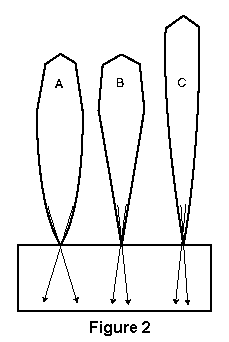Yeah, I've seen those videos and I have some issues with his "treatises" on the Katana. First off, he admits that he is not an expert on the katana, and, in fact, has very little experience with them. He is a HEMA enthusiast (European sword arts), and, therefore, has a bias towards European blades. Granted, he is a little less biased than one or two other "HEMA" fans on Youtube i've seen videos by, but still. Given that, I have to take his opinions on the Katana with a grain of salt. It is one thing of note about his last video which is important to our little discussion, and which supports what I've been saying about how much better a Katana can cut vs a European straight bladed sword. Even, scholagladiatoria says that a curved blade cuts better than a straight blade. His choices for the best cutters have extremely curved blades. A curved blade concentrates the cutting power of the swing in a smaller area creating more force per square inch. The other factor for a Katana's better cutting and thrusting power, is the stiffness of the blade (not to be confused with hardness), while by no means"rigid", the katana does have a stiffer blade than a European long sword, much like a heavy-duty leave spring is stiffer than a light duty leave spring. This is because the katana typically has a thicker cross section at its thickest point, the shinogi. This means, it will drive into its target with more force before bending.
But he has had experience with them, and as he also said he does know people who are very experienced with them as well (which it did sounds like he does speak with when it comes to the Katana). And the fact that he is not blinded by what movies, tv-series, games, anime/manga stuff... about the Katana, where it tends to pretty much be shown to have qualities that it could possibly not have... but rather looks at the weapon for what it actually is... and really I have not once heard him say that Katanas are bad weapons, and do praise them, and only really coming down on it when it comes to what a lot of people tend to claim Katanas are capable of (when they are in fact not capable of all a lot of people think they are)... then I do think his opinions is valid and valuable.
Also... calling him an just an "enthusiast" is a bit unjust. I mean he "only" runs one of the oldest and biggest HEMA groups in UK, he has been tampering with HEMA stuff since 97 and has been teaching it since 2000, he is the director of one of the biggest HEMA annual events, his formal educational background is in Medieval Archaeology and History, amongst a lot of other things that he does etc.
Some would maybe think all of this is evidence of that he would somehow be biased, but nothing of what he has said has made me think that... he does not seem to bash the Katana, neither does he claim that european swords are somehow entirely superior to the Katana (most weapons will have both plus's and minuses... including the Katana). If anything he seems to be very willing to give praice where it is due, but not look awayand ignore the downsides of a weapon... be it if it is the kinds he prefer, Katanas, or any other type of weapon.
Also... being able to cut very well is not everything when it comes to swords. That is just one single aspect of it all.
Also, a bad thing about the Katana when it comes to thrusting attacks... the fact that it is as thick as it is... is a problem. Yes, it will puncture what ever it is easier then most other swords, especially harder materials... but, due to it's thickness, which is significantly more so then most european swords, it will be stopped pretty fast... you might get in a few(several centimeters, but then the thickness of the blade is going to start working against it. Another problem with thrusting, that you would only really see if someone with a Katana went up against someone with european swords, is the length of the weapon. The Katanas blade is unusually short... yes you can get longer ones, but so can you with european ones.
All I really am saying when it comes to the Katana is that as a weapon in general, it is not really better then other weapons. It has it's pro's and it's cons, areas where it performs better, and areas where performs poorely, as does all weapons.
Now, when it comes to puncturing armor the katana has an advantage on most (obviously those designed specifically for this have an advantage) european swords due to the design of it's point and the quality of it's steel/construction.
I don't neccesarily think it does... at the initial point of the hit it does have a much better chance to pierce what ever it is hitting... but due to the thickness of the blade, a thickness that you get to pretty quickly after the point of the blade (most katanas, from what I have read, tend to be equally thick through out the entire blade, except for the last few centimeters where it goes into the point). I would then due to that argue that there might be a chance that it actualy does not penetrate as far as other sword's (who also managed to pierce the same thing) might.
A lot of european swords to stay pretty thin pretty far up the blade from the tip... especually the ones who where made for thrusting and piercing attacks. Of course, due to that it is not as good at that initial piercing when it hits... but if it does pierce it will possibly go deeper then what a Katana does.






